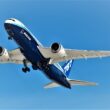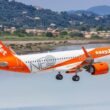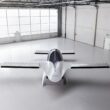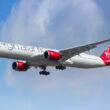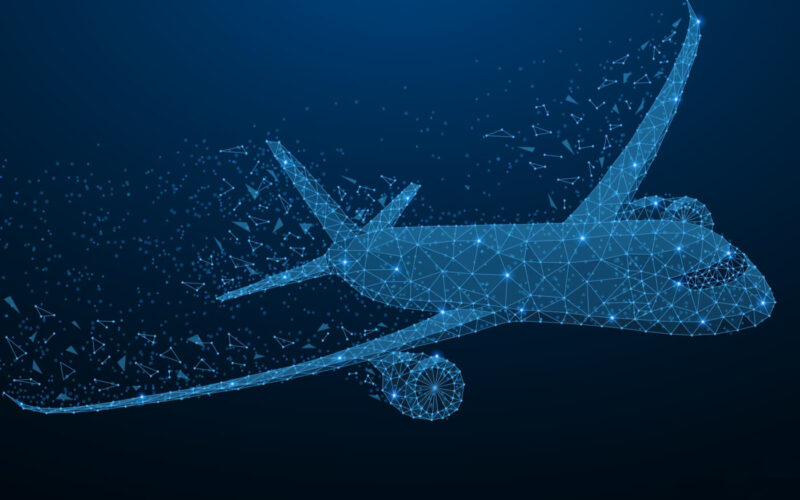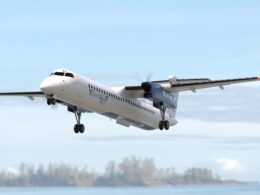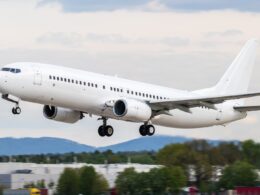From Boeing’s tainted 2019 debuts to Russian and Chinese market newcomers, here are some brand new passenger aircraft to take shape and the spotlight in 2020.
Boeing 777X, NMA, MAX
Boeing is starting 2020 with a new CEO, halted production of the 737 MAX, and plenty of mess in need to be fixed. The year 2019 has, no doubt, been very difficult, as the two crashes of 737 MAX and the mayhem that followed (read more about it in Boeing Part I, II, III, IV, V) had not only cast a shadow on the company and its best-selling 737 series but across all its programs. Too bad for Boeing, which had some big news up its sleeve regarding new aircraft.
As the much awaited launches and announcements were overshadowed, here are three big news that have been postponed to 2020:
Boeing 737 MAX. Much has already been said about the (infamous) 737 MAX aircraft family. What has been, perhaps, overlooked, is that once the family is finally certified ‒ presumably in 2020 ‒ there could be more MAXs taking off than just the ones currently grounded.
Boeing 737 MAX family is made up of two variants, the Boeing 737 MAX 8 and 9, which are already in airlines’ fleets and two still in the making ‒ the MAX 10 and 7. The shortest sibling of MAXs, the 737 MAX 7, was previously due to enter service in 2019. The date could now be sometime in 2020.
The production of the MAX 7 was launched in 2014 and the first aircraft was rolled out of Boeing’s Renton facility in the U.S. in February 2018, shortly thereafter completing its maiden flight in March 2018. Initially, Boeing 737 MAX 7 was supposed to be delivered for the launch customer Southwest Airlines (LUV) in January 2019. However, the U.S. low cost giant is believed to have postponed the deliveries until 2023-2024, giving up the queue for the Canadian low cost carrier WestJet, which has also converted its first four orders for MAX 8, postponing delivery of its first MAX 7 to 2021.
Meanwhile, the fourth and the last member of the family, the Boeing 737 MAX 10, has officially debuted in the company’s Renton, Washington, factory on November 22, 2019. Seating up to 230 passengers, the MAX 10 is the largest plane in the MAX aircraft family. The maiden flight of the MAX 10 is scheduled in 2020.
Boeing 777X. A successor of aging Boeing 777-200LR and 777-300ER models, once in service the 777X is promising to be a truly impressive aircraft. With its huge folding wings (the first of the kind on commercial passenger aircraft) and engines as wide as the body of a McDonnell Douglas MD-90, it is going to be the first twin-engine jet to be able to carry more than 400 passengers.
The 777-9 can seat 400 to 425 passengers in a standard configuration and offer a range of 7,600 nautical miles (14,075 km). Regarded as a competitor to Airbus A350XWB or even the A380, the aircraft is to come in two versions: the first model introduced is going to be the 777-9, followed by 777-8.
On March 13, 2019, Boeing was supposed to publicly roll out the first 777-9X at their Everett facility in Seattle. After Ethiopian Airlines flight ET302 crash three days prior to the event, the company indefinitely postponed the public ceremony, instead quietly revealing it only for the company’s employees.
Yet the aircraft program had plenty of problems on its own. In September 2019, a cargo door on a Boeing 777X static test plane “blew out” during a ground stress test. The fuselage of the test aircraft suffered a high-pressure rupture just as it approached its ultimate load required to certify the jet, the manufacturer later confirmed.
While Boeing claimed the incident would have no significant impact on the overall test program schedule, it was already experiencing delays due to problems in the development of the massive GE9X engine purpose-designed for the new jet. It appears that GE Aviation has managed to fix the issue with its GE9X, involving the engine’s stator vanes. New photos that appeared on December 17, 2019, showed the GE9X engines already installed on the 777X.
This might just mean that, according to the initial plan, the first flight of 777X would take place in early 2020 and the first delivery in 2021.
Boeing NMA. While never formally committed to producing a new middle of the market aircraft known as the NMA or, sometimes, 797, it is known that Boeing has been working on the concept for some time now. In fact, it was even expected to be “closing in” on the decision in early 2019.
Viewed as a potential replacement for the aging Boeing 757 or 767 fleets, the Boeing NMA is expected to be the company’s attempt to focus on the overlooked “middle of the market”. The aircraft would be then designed for the 8 to 10-hour travel, on routes such as New York to Los Angeles in the U.S., or medium-range flights connecting the U.S., say, Chicago, to cities in Europe.
The new aircraft was already anticipated by some airlines, particularly large 757 and 767 operators like Delta Airlines (DAL) , whose CEO’s once said that the carrier was “very interested in it” and could potentially opt for as many as 200 NMAs over the next decade. However, as no news came from Boeing and other 757 operators began opting for Airbus A321XLR (in particular, United ordered 50 A321XLRs to replace its 757s in December 2019), the year 2020 might just become the year when all hopes of seeing the NMA program take shape and come into existence becomes finalized ‒ one way or another.
Any news on Airbus A220-500?
Amidst all Boeing initiatives and projects in progress, a question imposes itself: what can we expect from Airbus? Not much for next year, it appears. Besides launching the A321XLR during Paris Airshow 2019 (to enter service sometime in 2023), the Toulouse-based manufacturer has kept shut on any other possible derivative, even more so on completely new designs of commercial passenger aircraft.
There are some speculations, though. The stretched version of A220, dubbed the A220-500, has already caught customers’ interest. Currently, the A220 family is composed of two types: the A220-100 model, which seats 100-120 passengers, and the larger A220-300, seating 120-150. The idea of a third A220, seating up to 175 passengers, dates back to the times when the airliner was still called Bombardier C-Series. In addition to CS100 and CS300, Bombardier also planned a larger version, the CS-500.
In July 2019, Air France KLM (AFRAF) has expressed interest to acquire 60 Airbus A220-300 aircraft. The order appears not to have been finalized yet, as the manufacturer’s order book does not refer to it (as of November 2019). However, in a presentation to investors (dated November 5, 2019), Air France-KLM refers to the A220 family as a possible medium-haul aircraft within Air France’s future fleet. Besides the obvious A220-300, it also lists a potential A220-500.
And Air France-KLM is definitely not alone sharing the belief that the A220 family is missing a member and that a stretched version is possible. Previously, similar ideas have been publicly discussed by airBaltic, Delta, British Airways, and Korean Air bosses.
Airbus itself has been ambiguous when discussing the possibility, saying neither “yes” nor “no”. Take, for instance, the CEO of Airbus Canada Philippe Balducchi’s comments for Reuters in November 2019: “It’s no secret that the aircraft has a potential to be stretched, potential to grow,” Balducchi told the reporter. He also added that Airbus is primarily focused on fully establishing the two already existing A220 versions, before moving on to consider the stretch version.
So maybe 2020 becomes the year when Airbus finally commits itself to the idea?
Mitsubishi SpaceJet M90 service entry?
Mitsubishi announced its regional jet program (then called the Mitsubishi M90) in 2008 with the initial target date for the jet’s service entry set to 2013. After multiple delays, the manufacturer broke out of a standstill as the aircraft (now called the SpaceJet M90) entered flight testing in March 2019, bringing hope that the year 2020 becomes the year when we finally see it entering service.
However, SpaceJet M90 service entry with Japan’s All Nippon Airways (ANA) in the mid-2020 now appears to be hanging on a thread. Reports indicate that the company is considering a possible pushback of the schedule by six months, in which case the service entry would likely be a year later ‒ in 2021.
In late November 2019, Mitsubishi Heavy Industries Chief Executive Seiji Izumisawa told Reuters that he “cannot commit” to the mid-2020 hand-off date, thus indirectly confirming speculation of a schedule revision, which has been going on since October 2019. Back then, the company’s spokesperson told AeroTime “there has been no official announcement or comment on our schedule” back then. Whether or not SpaceJet M90 enters service on time, we will surely see a lot more of the Japanese regional aircraft in 2020.
New entrants to take final shape
Both Russian MC-21 and Chinese C919 commercial passenger jets are expected to finish certification and enter service in 2021. However, as the final year of development programs, 2020 should offer plenty of milestone news coming from both of them.
The MC-21, a Russian response to the Airbus A320 and Boeing 737 narrow-body families, is going to seat up to 211 passengers and have a maximum range of 3666 miles (5900 kilometers). Currently powered by Pratt & Whitney PW1400G-JM engines, the airliner will eventually have a second, Russian-made, engine option of Aviadvigatel PD-14.
The first MC-21 prototype made a maiden flight in May 2017 and currently, four MC-21-300 prototypes are undergoing testing. The latest (fourth) prototype made its first flight on December 25, 2019. The fifth prototype fuselage has already been assembled as well. What is special about this particular airframe is that it will be equipped with PD-14 engines. Flight tests of it are scheduled for 2020.
Besides the show-off of the new engines, the airliner is also expected to enter service with Aeroflot in 2020. However, UAC general director told Russia’s Federal Council (as reported by Russian Aviation Insider) of the plans to have six serially built MC-21 aircraft in 2021 and twelve 2022, indicating that service entry might have been postponed.
Meanwhile, the Chinese response to the same narrow-body category, the C919, is also moving forward and appears to be one step ahead of the Russian counterpart, as all six prototypes of the airliner-in the making are already flying.
China established COMAC in May 2008, announcing plans to produce its first commercial jetliner. The initial design was completed in April 2009, but the first C919 was presented to the public only in November 2015. In May 2017, the first prototype C919 successfully performed its maiden flight. In December 2019, the last two of six prototype aircraft began flight testing. COMAC is currently targeting 2021 for certification process culmination and first deliveries to customers.

